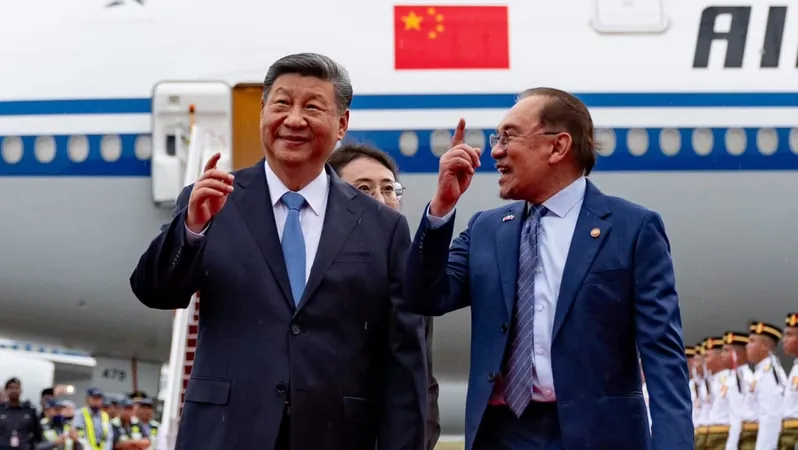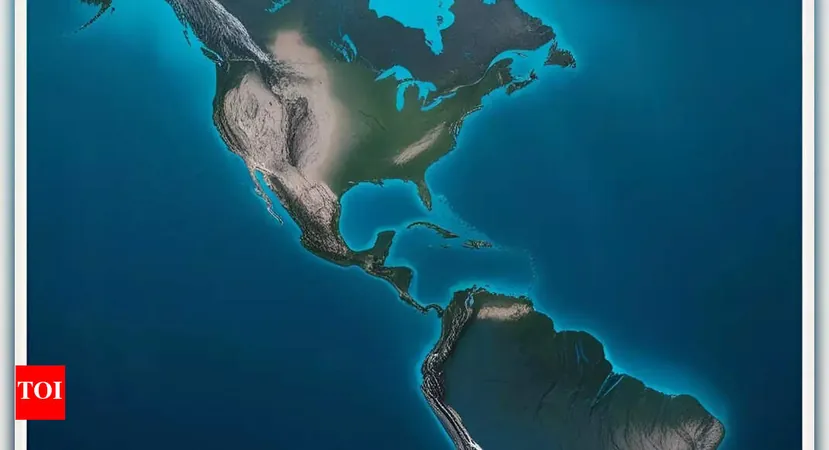
The Impact of Trump's Tariffs: A Looming Crisis for ASEAN Economies and Political Fallout for Leaders
2025-04-08
Author: Siti
Kuala Lumpur/Johor Bahru – The recent tariffs imposed by U.S. President Donald Trump pose a potential economic crisis for key Southeast Asian economies. Analysts suggest these measures could lead to significant declines in growth rates and political pressure for the leaders of affected nations.
In response to the sweeping 10% baseline levy on U.S. imports and country-specific tariffs affecting various stability measures, ASEAN leaders, including those from Indonesia, Malaysia, Thailand, and Vietnam, are scrambling to mitigate the economic fallout. Negotiations with the Trump administration may be on the table, but experts warn that failure to achieve satisfactory agreements could necessitate emergency fiscal measures to support their citizens.
ASEAN's Economic Coordination and Challenges
As chair of ASEAN, Malaysia is spearheading efforts to formulate a unified approach to the tariffs, with a special meeting for ASEAN Economic Ministers scheduled shortly. However, analysts note that the United States does not view ASEAN as a singular regional powerhouse; hence, some member countries are pursuing bilateral negotiations. Edwin Oh Chun Kit, an independent socioeconomic analyst, suggests that ASEAN could provide the U.S. with selective concessions in trade terms to facilitate dialogue without compromising regional interests.
The recent tariffs have led economists to downgrade growth projections for the six largest ASEAN economies—collectively known as the ASEAN-6: Indonesia, Malaysia, Thailand, Vietnam, Singapore, and the Philippines. Growth forecasts for these countries have been slashed by banks, emphasizing the potential economic strain.
Vietnam is expected to experience the hardest hit with a 46% tariff, while Thailand, Indonesia, and Malaysia face significant levies of 36%, 32%, and 24%, respectively. Despite these grim forecasts, the likelihood of a recession isn't anticipated for the overall ASEAN-6, as domestic demand remains a driving factor in these economies.
Political Ramifications for Regional Leaders
Political analyst Cassey Lee suggests the leaders of Indonesia, Malaysia, Thailand, and Vietnam are particularly vulnerable as the tariffs affect key economic sectors, including electronics and manufacturing. Indonesia's newly elected President Prabowo Subianto may find his ambitious goal of achieving 8% annual economic growth difficult with the imposition of the U.S. tariffs directly affecting crucial export markets.
Moreover, rising public dissatisfaction over economic conditions could undermine confidence in leadership, particularly for Prime Minister Anwar Ibrahim of Malaysia. With voters quick to associate economic hardships with governmental performance, Anwar's administration could face scrutiny over rising prices and job loss attributed to external trade policies.
In Thailand, the government led by Paetongtarn Shinawatra has promised support measures for businesses affected by tariffs, but there are concerns that slow or uncoordinated responses could exacerbate public discontent and lead to increased calls for accountability.
Southeast Asia's Navigational Strategies Amid Tariffs
As the region grapples with these challenges, some countries are proactively negotiating certain trade concessions with the U.S. Vietnam’s proposal to eliminate tariffs on U.S. imports has garnered attention and is seen as a potential diplomatic route to alleviate pressures on its economy. Similarly, Indonesia aims to engage the U.S. through strategic imports like liquefied natural gas and soybeans, presenting them as negotiation tools.
ASEAN nations, particularly those with overlapping territorial claims in the South China Sea, may have a unique geopolitical position to leverage in negotiations with the U.S., focusing on mutual trade interests, particularly in critical minerals like nickel and copper, which are in demand.
Critics and supporters of the ASEAN bloc's collective strategy remain divided. Some argue this unified front could enable countries to negotiate better terms with the U.S., whereas others believe that individual pursuits could serve national interests more effectively.
Conclusion
The impending economic fallout from Trump’s tariffs sheds light on the intricate interdependencies of global trade and the localized consequences for Southeast Asian nations. As they navigate this turbulent landscape, the political futures of their leaders will likely hinge on their ability to cushion economic shocks and preserve domestic stability in the face of external pressures. The actions taken now may define not only the economy but also the political landscape of the region for years to come.




 Brasil (PT)
Brasil (PT)
 Canada (EN)
Canada (EN)
 Chile (ES)
Chile (ES)
 Česko (CS)
Česko (CS)
 대한민국 (KO)
대한민국 (KO)
 España (ES)
España (ES)
 France (FR)
France (FR)
 Hong Kong (EN)
Hong Kong (EN)
 Italia (IT)
Italia (IT)
 日本 (JA)
日本 (JA)
 Magyarország (HU)
Magyarország (HU)
 Norge (NO)
Norge (NO)
 Polska (PL)
Polska (PL)
 Schweiz (DE)
Schweiz (DE)
 Singapore (EN)
Singapore (EN)
 Sverige (SV)
Sverige (SV)
 Suomi (FI)
Suomi (FI)
 Türkiye (TR)
Türkiye (TR)
 الإمارات العربية المتحدة (AR)
الإمارات العربية المتحدة (AR)